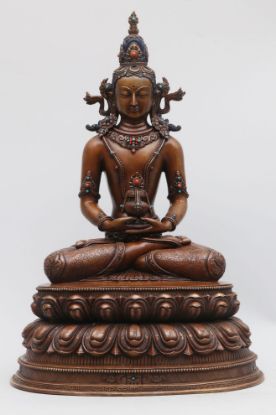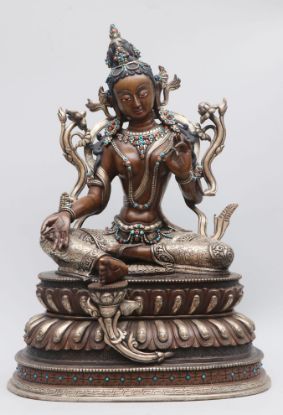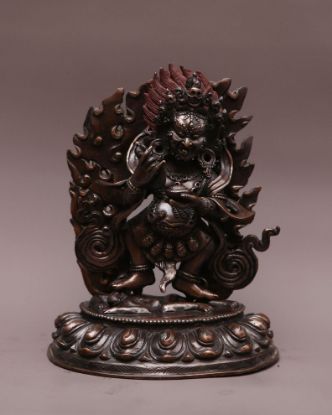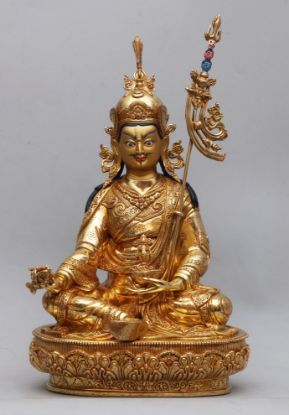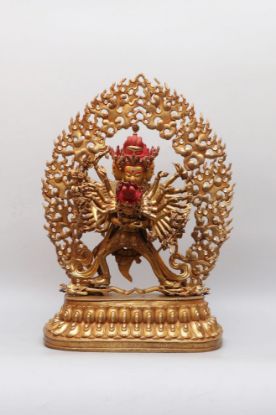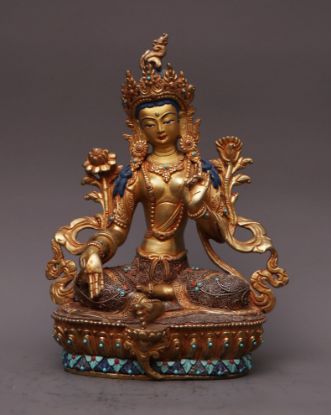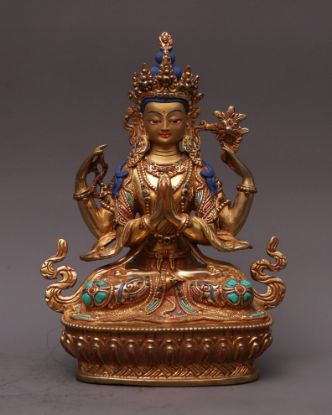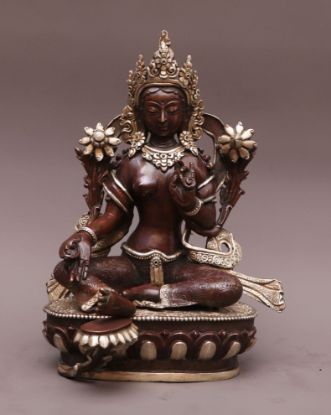Free Shipping Worldwide
Filter by price
Filter by manufacturer
Superior Quality
Featured products
Aparmita Statue | Handmade | Copper Oxidized
Aparmita is the name given to Amitabha in his character of bestower of longevity.
Aparmita is the name given to Amitabha in his character of bestower of longevity.
Height 10" | Weight 2.780Kg | Width 8"
$1,491.00 excl tax $1,640.10 incl tax
Arya Tara Statue | Green Tara | Handmade | Copper Oxidized
The Arya Tara is regarded as spritual consort of Amogasiddhi, the Dhyani Buddha.
The Arya Tara is regarded as spritual consort of Amogasiddhi, the Dhyani Buddha.
Height 15" | Weight 6.2kg | Width 10.3"
$1,633.00 $1,562.00 excl tax $1,718.20 incl tax
Mahakaal Statue | Mahakala Statue | Handmade | Copper Oxidized
Mahakaal is regarded as a Protector of the Dharma and a wrathful manifestation of a Buddha.
Mahakaal is regarded as a Protector of the Dharma and a wrathful manifestation of a Buddha.
Height 20cm | Weight 2.0Kg | Width 16cm
$284.00 excl tax $312.40 incl tax
Padma Shambhav | Guru Rinpoche | Handmade | Gold Glided
Padmasambhava ("Born from a Lotus") also known as Guru Rinpoche (Precious Guru).
Padmasambhava ("Born from a Lotus") also known as Guru Rinpoche (Precious Guru).
Height 10" | Weight 5.3Kg | Width 8"
$1,775.00 excl tax $1,952.50 incl tax
Kalachakra Statue | Handcarved | Gold Gilded
A Kalachakra statue represents the powerful deity of time and cycles in Buddhism. With multiple arms and faces, it symbolizes the union of wisdom and compassion. Used in meditation, the statue embodies mastery over the universe's interconnected energies, guiding practitioners toward enlightenment and spiritual transformation.
A Kalachakra statue represents the powerful deity of time and cycles in Buddhism. With multiple arms and faces, it symbolizes the union of wisdom and compassion. Used in meditation, the statue embodies mastery over the universe's interconnected energies, guiding practitioners toward enlightenment and spiritual transformation.
Height 26.6" | Weight 20.5kg | Width 17.5"
$6,879.90 excl tax $7,567.89 incl tax
Virupa I Copper Oxidized | Silver Plated
Virupa is also known as Virupaksa and Tutop Wangchuk, was an 8th-9th century Indian mahasiddha and yogi, and the source of important cycles of teachings in tantric Buddhism.
Virupa is also known as Virupaksa and Tutop Wangchuk, was an 8th-9th century Indian mahasiddha and yogi, and the source of important cycles of teachings in tantric Buddhism.
Height 34cm | Weight 5.1kg | Width 24cm
$1,327.70 excl tax $1,460.47 incl tax
Kuber Thanka | Jambhala Thanka
Kuber also known as Jambhala is a wealth deity whose blessings remove the obstacle of poverty.
Kuber also known as Jambhala is a wealth deity whose blessings remove the obstacle of poverty.
Height 43cm | Width 31cm
$28.40 excl tax $31.24 incl tax
Arya Tara Statue | Green Tara | Gold Glided
Green Tara is associated with compassion and wisdom, and reciting her mantra helps us develop these qualities.
Green Tara is associated with compassion and wisdom, and reciting her mantra helps us develop these qualities.
Height 22cm | Weight 1.5kg | Width 13cm
$710.00 excl tax $781.00 incl tax
Khadcheri Statue | Chenrezig | Handmade | Gold Gilded
Khadcheri, or Chenrezig, is the Bodhisattva of Compassion. He shows love and care for all, promising to guide them to wisdom.
Khadcheri, or Chenrezig, is the Bodhisattva of Compassion. He shows love and care for all, promising to guide them to wisdom.
Height 22cm | Weight 1.5kg | Width 11cm
$710.00 excl tax $781.00 incl tax
Arya Tara Statue | Green Tara | Copper Oxidzed | Silver Plated
The Green Tara mantra, Om tare tuttare ture swaha, is one of the most commonly recited in Tibetan Buddhism and is used as a veil of protection as practitioners face physical or emotional challenges.
The Green Tara mantra, Om tare tuttare ture swaha, is one of the most commonly recited in Tibetan Buddhism and is used as a veil of protection as practitioners face physical or emotional challenges.
Height 23cm | Weight 2.1kg | Width 13cm
$426.00 excl tax $468.60 incl tax
Zambhala Statue | Kuber | Copper Oxidized
Jambhala, also known as Dzambhala or Zambhala, is a Buddhist deity associated with wealth and prosperity.
Jambhala, also known as Dzambhala or Zambhala, is a Buddhist deity associated with wealth and prosperity.
Height 21cm | Weight 1.8kg | Width 14cm
$319.50 excl tax $351.45 incl tax

